FAQs on Freshwater Angelfish Infectious Disease
(Virus, Bacterial, Fungal)
FAQs on Angelfish Disease:
Angelfish Disease 1,
Freshwater Angel Disease 2,
FW Angel Disease 3,
FW Angel Health 4,
FW Angel Health 5,
FW Angel Health 6,
FW Angel Health 7,
FW Angel Health 8,
FW Angel Health 9,
FAQs on Angelfish Disease by Category:
Diagnosis,
Environmental,
Nutritional (e.g. HLLE),
Social,
Parasitic (Ich, Velvet...),
Genetic,
Treatments,
Related Articles:
Freshwater Angels,
Discus,
Juraparoids,
Neotropical Cichlids,
African Cichlids,
Dwarf South American Cichlids,
Asian Cichlids,
Cichlid Fishes in General,
Related FAQs:
Angels 1,
Angels 2,
Angelfish Identification,
Angelfish Behavior,
Angelfish Compatibility,
Angelfish Selection,
Angelfish Systems,
Angelfish Feeding,
Angelfish Reproduction, & FAQs on:
Wild Angels (P. altum),
Cichlids of the
World, Cichlid Systems,
Cichlid Identification,
Cichlid Behavior,
Cichlid Compatibility,
Cichlid Selection,
Cichlid Feeding,
Cichlid Disease,
Cichlid Reproduction,
|
|
|
Advice on gill infection
2/19/20
Hello WWM,
<Hello Amy,>
I rescued a 20g aquarium of fish from a man who was relocating and
intended to flush them. Three quarter size Angelfish and a dwarf
Gourami. I will include photos. The white Angel would not eat
and never left the bubbles under the filter. He had significant red
throughout the gills, under them and to the front of the gills. Also
behind the eye. This all looked like blood to me, his respiration was
frantic and he could not close his operculum. Both sides.
<Understood. Could be Gill Flukes, as you suggest below, but might just
as easily be genetic (bear in mind these fish are small enough you can
see the blood flow to the gills, and the gill filaments should be deep
red anyway) or else some sort of bacterial infection (Angels are
somewhat prone to septicaemia, for example). Velvet is another
possibility, being very much associated with the gills, even if the rest
of the fish seems unaffected, at least early on in the infection.>
My best guess was gill flukes and I treated 6 days with Prazi Pro. We
were 2 days into the treatment with some improvement before I thought to
take photos of him. The first photo was taken at this time, the red had
lessened and the area was a bit smaller. I finished 6 days of Prazi and
took the second picture.
<Right.>
Day 2 of Prazi Pro
Now on day 7, having just finished Prazi treatment, he is significantly
better on inspection.
<Would seem to be, yes.>
The gills close now, he finally started coming out to eat on day 5 and
his appetite is better yet today. Not normal, just slight improvement
each day. My concern is that his behavior is still not yet normal. He is
out and about the tank maybe 50% of the time but returns frequently to
the filter bubbles, nose up to the surface. He eats, but is slow and not
enthusiastic yet as he should be. Respiration does seem more normal now.
<Angels are often (usually?) not sociable when kept in twos and threes.
They can be extremely aggressive towards each other, in fact. So I you
have 2-3 Angels, and one of them is acting shy and withdrawn, he could
very easily be the weakest male in the group, and consequently at the
bottom of the pecking order.>
My question is if I should just give him clean water and time to see if
he continues to improve or should I assume that if he had flukes, he may
also have lingering infection in the gills. Should I dose the tank with
antibiotic?
<Dosing cichlids with Metronidazole and a Furan antibiotic is a common
approach with cichlids that rarely causes problems. It treats a good
range of possible pathogens, including Hexamita. Indeed, the combo is
close to being 'standard operating procedure' for many cichlid-keepers,
especially those handling wild-caught or expensive specimens.>
I have Furan 2, Kanaplex, Triple Sulfa. Is one of these antibiotics
better than another for gill infection?
Thank you for your help! I sure want this beautiful little guy to make
it.
Sincerely, Amy Larson
<Good luck, Neale.>
|
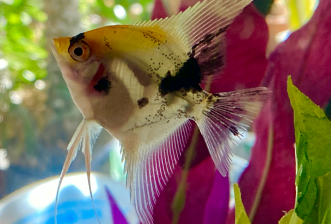
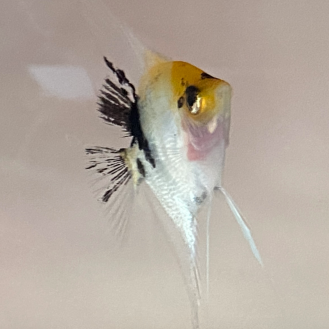 |
|
Re: advice on gill infection
2/19/20
Thank you Neale, I hope you never tire of helping us!
<You are most welcome.>
Just one question, do I give the full recommended dose of both Furan 2 and
Metronidazole at the same time? Amy
<I would; neither should be particularly risky for the fish, but do increase
aeration if possible, and do also use a nitrite or ammonia test kit during
usage to ensure the filter is happy. If in doubt, add some zeolite to the
filter to remove ammonia directly, as you'd do with a hospital tank. Cheers,
Neale.>
Re: advice on gill infection 3/2/20
Neale, Thank you for the help with the gill problem with my recently rescued
Angel fish. He is now doing great, eating well, happy gills. But I now have
another problem in this rescued tank. I think these are Camallanus worms? (A
different Angel in the same tank.)
<Video won't play for me <<Nor I>>, for some reason. But if red, thread-like
fibres emerging from the vent, then yep, Camallanus.>
The tank had a full treatment of Praziquantel followed by Metronidazole and
Furan for the gill infection. Today I noticed these worms in a different
fish, same tank (see photo) he is not eating. If these are Camallanus,
should I treat again with Prazi today or wait until the Fenbendazole arrives
on Tuesday?
<Prazi Pro isn't especially effective, so running a second course on the
same fish isn't unexpected. If the fish is otherwise healthy, and you think
holding out for the Fenbendazole is a safe choice, then sure, hold fire.>
Thank you once again for the time you gift to us. Amy
<Thanks for these kind words. Neale.>
Also...
Would Epsom baths help him?
<Marginally. Epsom Salt helps with constipation, but won't really have much
impact on worms. Cheers, Neale.>
|
|
Angelfish with white bumpy fins - not ich! 6/4/19
Hi Crew,
I've been searching for three weeks, consulted my forum, spent lots of time
Googling, and cannot figure out what is going on with the fins on these
angelfish.
<I see these.>
The story: I bought a pair of Koi angels at my local fish store. I should have
taken them back but here we are - I put them in my tank anyway. It's a cycled 75
gallon tank with just these two angels, 7 diamond tetras, and one tiny
Bristlenose Pleco. The tank ran for four months with a 6" Oscar, who I traded in
for these fish, which were all added together. The angelfish have these
white...bumps... on their fins. They haven't changed or moved, none have fallen
off and no new ones have appeared. There are no bumps on their bodies or on any
of the other fish. They do not exhibit any symptoms - no flashing, no clamped
fins, everyone eats GREAT and begs for food. They are all active and swim all
over the tank. Just these bumps... on the fins...
I, of course, thought it was ich at first, and treated with Seachem Paraguard
for ten days. When nothing changed, and at the behest of a couple of experienced
breeders, I stopped treating since it didn't appear to be ich and I didn't want
to medicate unnecessarily. I am doing daily 30% water changes. The only change I
have noticed is the bumps appear to be yellowing slightly, but nothing else has
changed. Calcium deposits and scar tissue have both been suggested. I just want
to find out what it is and what to
do, if anything, about it. I've been reading your site for years and learned so
much. I'm excited to see if you can help clear up this mystery!
Thanks,
Aimee
<My gut feeling is Lymphocystis or some other viral infection. These are
moderately common on advanced Perciform fish such as cichlids. There's some
debate about whether they're "just one of those things" or (more likely) caused
by some environmental stress factor such as heavy metals. Either
way, Lymphocystis is rarely fatal if it doesn't impact an essential part of the
body (such as the mouth) but it isn't easily cured either. The usual story is
that fish recover to varying degrees under their own steam, all else being
favourable, but that recovery may take years. Lymphocystis classically has
irregular, off-white lumps, sometimes with a cauliflower-like texture. Other
viral infections, such as Fish Pox, are similar, and actually identifying the
virus is well beyond the abilities of the average aquarist. What is interesting
about Lymphocystis is that it evidently isn't particularly contagious, so
there's no real need to isolate infected fish. Longer shot possibilities would
include Finrot (if associated with raggedy fins especially) and Anchor Worms
(these are distinctive little animals easily visible with a hand lens). Hope
this helps, Neale.>
|
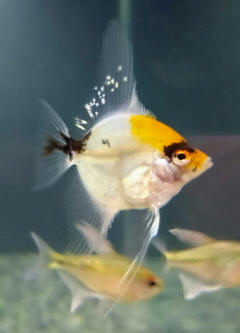 Re: Angelfish with white bumpy fins - not ich!
6/5/19
Thank you very much. I was afraid that would be the answer. I guess I will
just have to keep up with my water changes and hope for the best!
<Pretty much all you can do, unfortunately. It can clear up, but does take
a while. It's all about the fish's own immune system responding. So just as
with humans, optimising diet and reducing stress will both help. Perhaps
even adding vitamins to its diet, via products such as Selcon. Certainly a
balanced diet and frequent water changes. Cheers, Neale.>
|
Angelfish mouth problem 10/3/17
Hi there,
<Hello Nicki,>
I was wondering if you could help me out with diagnosing my angelfish.
<Sure thing.>
He is a male, about 1 year old. I had him in a 4x2x2ft tank (~400L) with about 4
other angelfish. I do weekly water changes, around 20-30%, with water treated
with dechlorinator only. Water temperature is at 28degrees
Celsius and I have an Eheim 2217 running on the tank (containing filter wool and
biohome media only).
<All sounds fine.>
About a month ago he started displaying red streaks around his upper lip (still
eating), no other fish appear affected and there were no other physical markings
on his body. I separated him into an isolation tank
(stopped eating) and treated with high dose of blue planet tri-sulpha (1 tablet
per 20L).
<Were the Angels fighting? Cichlids, including Angels, will do a "tug-o-war"
with their mouths when fighting, and very occasionally the jaws become damaged
or dislocated, the latter almost always fatal in the long term. On the other
hand, so-called Mouth Fungus, or Columnaris (actually a bacterial infection) is
a fairly common problem in tanks with poor water quality and/or physical
injuries on the fish.>
He did not appear to improve at all, and there was some inflammation around his
fin. I then treated with Waterlife Protozin for 3 days, changing about 10-20% of
the water prior to treatments. He did appear to improve with the
red streaks reducing. However, on the 4th day (which was a no treatment day),
all the red streaks returned even more severe than before and he had lost a
considerable amount of his upper lip.
<This does sound like Finrot and/or Columnaris. Antibiotics will help, if you
can use them. Outside of the US antibiotics are usually prescription-only, but
there are alternative medications. Protozin is, as its name suggests, designed
for use against Protozoans, and of little/no help against bacteria. I would
recommend a reliable anti-Finrot medication such as eSHa 2000 instead.>
I was wondering your thoughts on what he might have. I don't think its mouth rot
caused by bacteria, but I'm not entirely sure if its fungal either (there is a
lack of any white or cottony appearance). I also doubt it is septicemia as there
are no other red or bruising markings on his body.
<Red streaks are almost always bacterial, so I disagree with your analysis
here.>
Even if he was to recover, do you think he would still be able to eat with most
of his upper lip destroyed?
<It is unlikely if the jaw bones are actually gone. Angelfish 'inhale' their
food by extending their jaws into a kind of tube, then sucking in food
particles. Without their jaws working properly, they really can't feed
themselves. You have to observe and see if your specimen is feeding, and from
there make the appropriate decision.>
Kind regards,
Nicole
<Most welcome. Neale.>
Re: Angelfish mouth problem 10/4/17
Thank you for your fast reply!
<Welcome.>
I haven't heard of eSHa 2000 before, it certainly isn't available at the local
aquarium shops but I should be able to order it online.
<Indeed. It's Dutch, but widely sold in the UK. Other medications for Finrot and
Columnaris are available, but I find this one particularly effective and good
value. The Waterlife products, such as Protozin, I've just been disappointed by
a bit in the past, so tend not to recommend them.>
I was wondering, if you suspect it is bacterial then is there a reason why the
tri-sulpha didn't work? As this is a broad spectrum antibiotic and more
effective than superficial treatments.
<Difficult to say. Not all antibiotics work against all bacteria -- which is why
we have to use so many different kinds. Antibacterials like eSHa 2000 use dyes
and other chemicals that are less effective but also more broad acting, so tend
to be better bets provided the fish isn't too sick.
Also, some people use all medicines in ways that prevents them working, getting
the dose wrong, or worst of all, leaving carbon in the filter (which immediately
removes the medicine from the water).>
Kind regards,
Nicola
<Good luck! Neale>
|
Angel fish 5/25/13
Hi Crew,
<Laura>
It has been a while since I have written because everything has been
going well. I have attached a picture of my angel fish. These growths
appeared on it yesterday. I think it looks like cotton.
<... need to sample, look under a 'scope to be sure, but true fungal
issues are rare... This is likely bacterial following a trauma...>
It appears to be painful for the fish as the area around the growth is
very red. I tested my water and there is no ammonia and all other
components are within range. The angel fish is in with 3 hatchet fish, 6
bamboo shrimp, 3 peppered catfish, and 3 snails. The tank is 75 gallons.
The only thing that has been added recently is one bamboo shrimp. Any
advice provided will be greatly appreciated.
Thanks
Laura
<Read here:
http://www.wetwebmedia.com/ca/volume_6/volume_6_2/mycobactera.htm
and the linked infectious disease FAQs at the bottom. Bob Fenner>
|
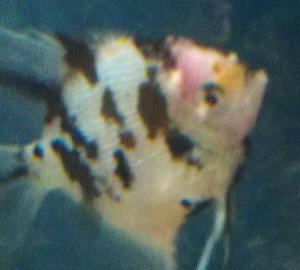 |
|
angel fish with suspected lip fibroma
6/12/2011
I have an angel approx. 2 years old that has what appears to be
lip fibroma. Its lips started getting big about 6 months ago and
I thought it was just maturing. They continued to grow to a point
that I knew it was not normal but the fish continued to appear
healthy and happy. I noticed yesterday that it could not get food
into its mouth to eat. It is trying to eat but the food bounces
off his lips. His tail fin has always been the way it looks in
the picture so no worries about that. In researching I have read
that there is no cure. I have seen mention of surgically removing
the growths. Can you tell me how to do this? If so please include
how to tell where to cut so that I do not damage healthy tissue.
Let me also mention that I will need explicit details from start
to finish, as I have never done anything like this before and
would like to ensure the best possible outcome. I have a 55
gallon tank with a few other angels which all appear to be
healthy. Thank you so much for your help!
<Hello Cynthia. This is very strange, and unfortunately, I can
think of no treatment for this condition. Surgery is out of the
question, at least at home. Fish have very delicate mouths that
are filled with nerves, and there's no way you could trim the
lips without [a] causing the fish immense pain and stress; and
[b] damaging the bones, muscles and lips and in the process
making the fish vulnerable to secondary infections. A vet *may*
be able help, but for a fish species this small, surgery would be
extremely difficult. In all likelihood this is a genetic problem
-- you have bought a "fancy" variety of Angelfish, and
these are inbred, especially the fantail ones, and if you look at
the shape of the ventral and tail fins of this Angelfish and the
others in the photo, you'll see lots of other deformities
too. It just so happens this deformity is so severe it's
become an eyesore.
Bottom line is that so long as the fish is feeding I wouldn't
worry too much; should the fish actually start to have problems,
then euthanasia may be the best way forward.
http://www.wetwebmedia.com/euthanasia.htm
Cheers, Neale.>
|
|
2.jpg-partExt=.jpg&&&outquality=90&ext=.jpg&limitsize=615,500
|
Re: angel fish with suspected lip fibroma
6/12/2011
Neale,
Thanks so much for the speedy answer. The fish has not eaten for 2
days, although it tries. The growths are so large that he cannot
effectively open its mouth which causes the food to bounce off his
lips. Can you recommend a food that may be easier for him to eat. I
feed brine shrimp, beef heart and flakes. I wonder if baby brine
shrimp would work or would it be more humane to buy some clove
oil?
Thanks so much for your help!
Cynthia
<Do try feeding finely powdered flake food first, a little at a
time. Yes, baby brine shrimp will be eaten, and can be surprisingly
good regular foods for even quite large fish. Daphnia are another
good option. The problem is more likely to be competition from
other Angelfish than actually finding something he'll eat.
Keeping the fish alone or with non-competitive tankmates (e.g.,
Corydoras) would be the best thing. In any case, you might be
surprised to see that some cichlids have lips much like these, but
deliberately so, as in the case of Abactochromis labrosus.
http://en.wikipedia.org/wiki/Abactochromis_labrosus
Cheers, Neale.> |
|
Angels mouth disintegrating? 3/4/13
Hello crew!
Hope you are all doing well.
I'm sadly, not so great and neither is my angelfish, King, about 10 days ago
i noticed my angelfish's mouth developed two holes on its upper lip, same
size, directing across from one another, they didn't seem to get bigger for
a while till about 2 days ago when i noticed they had not only progressed
downward but what was left of his upper lip was detached. Someone on
angelfish.net suggested that i wash his mouth with q-tip dipped in hydrogen
peroxide to make sure no bacteria was on his lip eating away at the tissue
<Not a worthwhile procedure; too traumatic, damaging; not effective.
Instead: Checking water quality, improving, perhaps some antibiotic in the
food, water... a concentrated bath immersion>
but of course because of his struggling i ending up hurting him more,
which i feel very terrible doing so. He now can no longer eat because of how
bad his mouth is, and I'm not very convinced if it ever heal with how bad it
is, here is a video of it (i tired to get pictures but its a lot easier to
see in a video):
http://crazy-fish-lady.tumblr.com/post/44421022193/here-is-kings-current-mouth-condition-he-can-no
<Does appear to be some sort of secondary infection eating away at the upper
mouth... from/following a physical trauma... maybe mouth - "wrestling" w/
another angel>
Do you think there is any hope for him?
<There is always hope>
People have suggested that it is from fighting
<Yes>
but I'm not convinced at all because i don't think fighting will cause two
holes on the roof of the mouth, and i have never once seen him fight let
alone pick at another fish/angel. But anyway here are my tanks current
conditions:
tank size: 55 gallon
filter is AquaClear 70, sponge and BioMax
ammonia 0ppm
nitrate and nitrites were also 0,
<... 0 Nitrate? How is this achieved?>
my tank cycle recently crashed
<Also a clue and probable cause>
but i have been keeping an eye on it and nothing has gotten worse sense
then.
Tank inhabitants are 4 angels (including king), 12 Rummynose tetra's, 1
golden gourami, 1 red tailed shark, an Oto and a brown Kuhli loach (given by
a friend who didn't want fish anymore) and a peppered Cory cat.
I do water changes weekly, 25%-50% thanks for reading! I look forward to
your answers.
--
Bailey Palmer
<I'd have you review what we have archived on Pterophyllum. Start here:
http://www.wetwebmedia.com/FWAngDisF8.htm
and read over the linked files above. Bob Fenner>
|
http://crazy-fish-lady.tumblr.com/post/44421022193/here-is-kings-current-mouth-condition-he-can-no
|
|
Angel Fish 10/6/10
Hi,
<Ave,>
I looked around your website for information on angel fish
diseases and such, but nothing I found seemed exactly what I was
looking for. My brother has an angel fish that he had staying at
our tank at home. It
started swimming sideways and developed a white fuzz over
his eye.
<Probably Finrot or Fungus, possibly a result of physical
damage to the eye, either through fighting or clumsy handling
when the fish was netted out.>
My brother thinks the eye was eaten by another fish (it used to
mingle with other angel fish), and that it's just a fuzz
growing over the wound.
<"Just" fuzz isn't the way I'd put; damage
to the eye is serious, and you can easily end up with a one-eyed
fish.>
He tried medicating it with something (I know, you probably need
more info than that), and the fuzz went down for a little while,
but it still swam sideways.
<Indeed. Fish use the direction of light to determine up and
down. Normally both eyes receive equal amounts of light from
above. But if one eye is damaged or blocked with
"fuzz", the fish might get the wrong signals, and
compensate by swimming off to one side.>
Now my brother is on vacation and I am house sitting. His angel
fish was moved back to his apartment into a tank by itself. When
I went to feed his fish this evening, the fuzz had developed into
a full on bubble of fuzz covering his eye.
<This is much, much more serious.>
I tried texting my brother to see if he knew of this change, but
he didn't respond. I don't want to kill his fish, but I
feel bad for the thing, it has to be suffering, right?
<"Suffering" is a difficult word to use here.
There's a tendency among some people to use
"suffering" as an excuse to kill a fish that's sick
so they can simply go buy another one. Such people have no
particular interest in the welfare of the fish and won't
spend money on medications; if a fish gets sick, it's like a
scratched CD or a leaky teapot -- you throw it out and buy
another one. Other people will medicate fish, but understand that
at some point euthanasia becomes the more humane option because
the fish can no longer be treated or even if it is treated,
it's quality of life will be very low. I can't make this
decision for you, but I will state this. Your fish could probably
be treated with an antibiotic; a good combination is using
Maracyn and Maracyn 2 at the same time, the two different drugs
generally treating a wide range of diseases. Epsom salt helps to
reduce swelling when used at a dose of 1 to 3 teaspoons per 5
gallons, but it is NOT a cure by itself, and shouldn't be
used as such. All it does is help the antibiotics work faster.
Since this infection is clearly a bacterial one, and the swelling
followed on from the initial fuzzy infection, the use of
antibiotics is doubly important here.>
Any ideas? I could send pictures if that would help.
<Yes. But do note we ask for pictures up to about 500 KB in
size, so don't send multi-megabyte files fresh from your
camera!>
Thanks,
Sarah
<Cheers, Neale.>
Re: Angel Fish 10/8/10
Thank you so much for your timely reply, I can't reach my
brother about his fish at all and I'm getting prettied
worried.
<As you should be. This fish is suffering from a fungal
infection. Treat as per fungus. Be sure to remove carbon from the
filter if you use it. Carbon removes medication.>
I checked on them after work again tonight and I noticed white
"fuzz" (as I've been calling it), starting to grow
on the rocks and such inside the tank.
<Fungus consumes organic matter. It doesn't matter if that
is damaged muscle and skin, uneaten fish food, or faeces. If
you're seeing fungus in the aquarium, it's very badly
looked after. I mean, filthy. Too many fish, or too much food, or
not properly cleaned. My guess is the tank is poorly filtered and
your brother doesn't make an effort to keep the tank
clean.>
I'm going to go back over and take some pictures to send to
you, then go and see if there is any place open selling the
medication you suggested.
Here are some photos of the eye that I took. I noted that the
temperature of the tank was about 78 degrees Fahrenheit, if that
matters.
<That's fine for Angelfish.>
I saw a bottle of QuickCure for Ick/Parasites near the old tank
that the fish was being treated in. I think my brother may have
been using that. My mom thinks that my brother was using Fungus
Guard, which claims to clear fungus and bacteria.
<Should certainly treat against Fungus, preferably with an
antibiotic as well.>
Whatever he used, it worked a little bit and I remember the white
"fuzz" on the eye went down, but now it's far worse
than before. I'm going to go out to look for the medication
you suggested, hopefully it will be a solution.
Thank you so much for all your help!
<I fear the eye is lost, but there's no reason the fish
should die.>
Thanks again!
Sarah
<Treat quickly, clean the tank, improve living conditions, and
you should be home free. Oh, and whack your brother with a
rolled-up copy of Tropical Fish Hobbyist when he gets back.
He's a very bad boy. Cheers, Neale.>
|
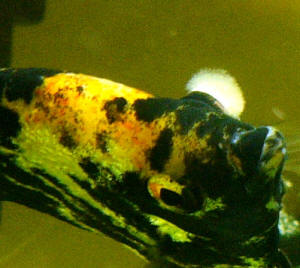
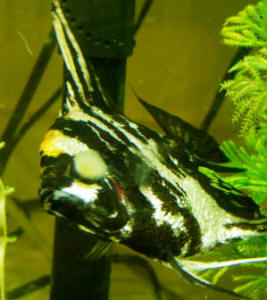 |
|
Marble Veil Angelfish with reoccurring Fin Rot
6/22/09
Hello There, I hope you can help me, as I have gained valuable
information from your site many times.
<I'll do my best to help!>
I have had an angelfish for approximately a year and a half. I
got it when it was about the size of a quarter, it is now full
grown to approximately 6 inches, well almost, if not for her tail
fin.
<That's a pretty good growth rate! So you're probably
doing most of the right things already. Angelfish are fairly
hardy, but the veil-tail forms are, unfortunately, that bit more
delicate than the short-fin sort.>
The fish had torn fins when I purchased her long ago, which I did
not notice until the next few days after I got it. Long story
short, she continues to have it, get better, then get it again,
and tail has never been completely full. I have tried everything
that has been suggested on line including medications, water
conditions, weekly tank and filter maintenance. Proper and varied
food.
<The thing with veil-tail fish of any kind is that they
don't have "natural" fins. The blood flow and
immune system evolution produced for these fish is adequate for
fish with regular fins, but with long-finned types, these systems
are overloaded. It's a bit like why shorthair cats can
usually groom themselves just fine, but longhair cats invariably
need help from humans, otherwise they get furballs. So with
veil-tail Angels you need
to be that bit more solicitous in terms of water quality.>
She has always eaten like a piggy, and seems okay, except for the
tell tail sign of fin loss and fin ray loss, and occasional white
edged rays, and tissue, etc. One individual from allexperts.com,
whom I sent a photo
to, told me these were just pimples, like we get, and she looked
healthy, also that the fins will slough off several times after
medicating, and once medicated the fin rot will not come back. I
don't buy it, this is not
normal.
<I would broadly agree. While fish certainly can get pimples
and harmless cysts, just like any other animal, in this case,
I'd be a little more open minded. Specifically, Finrot begins
with the development of tiny blockages in the blood vessels that
go through the fin membrane. These swell up, becoming obviously
off-white lumps, and then eventually when all the tissue dies
because of the blocked blood flow, you see the red inflamed
tissue underneath. With no more blood, the nearby skin tissue
dies, and that's why the fin membrane erodes.>
I have tried the medications as follows: Jungle Fungus tabs,
Maracyn TC; Maracyn II; Melafix; Pimafix; Furan; Jungle
Anti-bacterial Food, CopperSafe, Quick Cure.
<Not all of these are Finrot medications, in particular things
that combat fungus or Protozoans won't do any good at all.
But more importantly, if the aquarium conditions aren't
"just right", the disease will keep coming back.
It's important to realise that the bacteria that cause Finrot
are present in all aquaria. They do good, even! They're part
of the nitrogen cycle, breaking down organic material (such as
uneaten food) into the ammonia that the filter bacteria handles.
The problem is that if your fish are stressed, their immune
system weakens, and these otherwise harmless bacteria are
"allowed" to digest healthy fish tissue as well as
their usual dead
tissue.>
All these medications, followed directions to the "T",
then no medications and just clean water and good husbandry,
throughout the year and a half.
The fish should be dead already with all the medication. I just
don't get it. Tank is 29 gallon; No Ammonia, No Nitrites, 5
ppm Nitrates. PH 6.8. Soft GH/KH. One HOT Micro Magnum Filter (I
reduce the out take with something to cut flow, so I don't
blow fish out of tank) for a 55 gallon tank, and one Whisper Bio
Filter for a 30 gallon tank, so plenty of circulation and
filtering.
<While the water quality sounds good, I'd perhaps try
testing the ammonia or nitrite across one day, maybe every 3-4
hours, to see if there are any spikes caused by, for example,
feeding. I'd also see how stable the pH is from water change
to water change, testing every couple of days. While soft water
sounds good in principle, in practise soft water aquaria often
exhibit pH swings (declines) as background acidification
overtakes the ability of the carbonate hardness (the critical
bit!) to compensate.>
Tank holds only the Angelfish and four Amano Shrimp, which just
got added recently, after quarantine, of course. I was thinking
of using Maracyn Plus next, its supposed to be okay for the
shrimp. Please HELP. I don't want her tail eaten up to her
imminent death, I fear this will eventually happen.
<I would look closely for the tell-tale lumps in the fin
tissue before doing anything else. Sometimes, veil-tail animals
have a ragged appearance, and there's nothing at all you can
do about it. But if there are lumps in
the fin, or patches of redness, then that's a key sign of
Finrot.>
Not to mention I am very anal and want the fish and animals I
care for happy and healthy. In addition, I just did a water
chemistry and the Nitrates are no Zero as well. Thank you again.
Lueppie
<Cheers, Neale.>
|
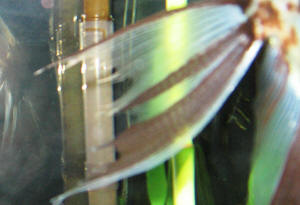 |
|
Re: Marble Veil Angelfish with reoccurring Fin Rot
6/23/09
Thanks Neale. I am assuming then you suggest no more medications,
and just make sure my PH, Ammonia, Nitrite are not fluctuating
throughout the day?
<Not quite. I mean, don't use medications "at
random", hoping one of them will work. Instead, decide what
the problem is (and it sounds like Finrot) and treat accordingly.
Maracyn is a good starting point, but if it doesn't work,
switch to Maracyn II; between them, these two different
antibiotics handle most of the bacteria that cause Finrot. Some
other products are listed here:
http://www.wetwebmedia.com/FWsubwebindex/fwfishmeds.htm
Although we've added Melafix to the table, it's not
really all that useful, and is at best a preventative rather than
a cure.>
If I decide to medicate again, what do you suggest I use this
time?
<Initially, Maracyn seems to work in many instances.>
Some more questions, if I may? I have a 14 gal quarantine tank,
which has Ick for second time. The second batch of fish, as
follows: 5 Black Neon, 3 Leopard Cory, 1 Guppy toddler, and 1
Cardinal Neon. I started with CopperSafe, but then read on
"Kordon's" site that new research finds that copper
is not good for the fish, and not to use it. As we both know Cory
and tetras are delicate, so I am now using the natural "Ich
Attack" medication from Kordon.
<Copper isn't necessarily dangerous, but yes, it is a
toxic. If used as indicated on the bottle, most fish aren't
bothered by copper-based medications. There are some exceptions
though, notably Clown Loaches, Mormyrids and various other
"oddball" fish. If you're worried about copper, the
best (and safest) alternative for treating Ick is the old
salt/heat method. All you do is make up a brine solution in a jug
containing 2 to 3 teaspoons of tonic (or kosher salt) salt per
gallon of water in the aquarium. When dissolved, pour into the
outflow from the filter. Raise the temperature of the aquarium to
between 82 and 86 degrees F. Leave thus for about two weeks, and
by the end, do water changes as per normal to flush out the salt.
Usually this treatment kills Ick as soon as the white spots
burst, and the salt concentration is too low to harm your fish
(or plants, or snails, or shrimps, or filter bacteria). It's
the method of choice where "delicate" fish are
involved.>
This I will use daily, with water changes, every other day, and
will treat for 32 days, do you agree with this treatment?
<It isn't what I'd do, but it should work.>
I am on the sixth day, and still see signs of ick. This is my
second batch of fish from the same source that got the ick the
first time, and these two instances are my first experience with
this, in over a year of fish keeping. Most of my fish are from
the same online store, just recently got this ick from them.
I treated the first ick batch with "Quick Cure", only
had 1 Black Neon, 4 Cardinal Tetras, and five Amano Shrimp, which
got moved to a bucket while treating with "Quick
Cure".
I treated twice with the Quick Cure (total of 6 days, at half
dose), then treated for 7days with the Ich Attack, at that time I
put the shrimp back into quarantine while treating with the Ich
Attack which is safe for them, just in case any ick attached to
shrimp. All seemed well. I kept this first bunch in quarantine
for two extra weeks, so in total these fish and shrimp were
quarantined for six weeks, with raised temp to 82. All visible
signs of spots were gone, so I gave cardinals to a friend, kept
the one black neon in quarantine to keep bio bacteria happy, and
put shrimp into angelfish tank. Then got the second batch, black
Neons, Corys, now this group of fish have ick. I am upset, I have
read that ick can be inside fish, even when signs are not
visible, that you should quarantine for longer then four
weeks, and treat for an entire month.
<No, no, no. The Ick life cycle lasts less than a week at
tropical temperatures. While inside the skin of a fish (including
the gills, but no deeper inside the body) the parasite can't
be killed. All, and I repeat ALL, Ick medications work by killing
the free-living parasites that emerges when the white cysts
burst. Hence, turning the temperature up speeds up the life
cycle, getting the Ick from the cysts to the swimming stages as
quickly as possible. Once all the swimming stages are killed,
that's it; the infection is done. It will never come back
unless there's something wet (a fish, a plant, a snail, a
net, a rock) carried from an infected aquarium to a clean
aquarium.>
Also that ick can actually take up to a year to really get rid
of. Quarantine for a year, really?
<No.>
Now I fear I have given away sick fish, so I am having friend
treat her tank with Ich Attack because she has pictus catfish,
and they are too delicate for other medications. Also, the shrimp
that are now in the angelfish tank came from the quarantine tank,
where the ick was, I moved them to angelfish tank once I thought
the first case of ick was gone, prior to the second batch of
fish, which now have ick. So should I assume the shrimp will put
ick in my Angelfish tank, and treat her tank with Ich Attack?
Also, I have a 52 gal that has been running for 7 months, all
fish put into this tank were quarantined, this prior to any ick
issues.
However, I noticed last week that one of the peppered Cory in the
52 gal, scratched itself on a rock. Now how on earth did this
tank get anything, and what should I do? No signs of spots, but
now I know that ick starts off not being seen. I always make sure
I do not put wet hands from quarantine into any other tanks, and
never mix equipment, each tank has its own, and no fish that had
ick have been put into the 52 gal tank. I thought maybe I should
use the "Ich Attack" for precautionary purposes on my
52 gal as well? I have 2 Amano Shrimp, Snails, Pleco, Corys,
Cardinals and live plants in the 52 gal, so medications have to
be used
that these animals and plants can handle. The 52 gallon has 0
Ammonia, 0 Nitrite, 10 ppm Nitrate, Temp 80, PH 7.6, Med/Hard
KH/GH, ideal buffering per test strips, UV Sterilizer, Wet/Dry
Filter, Magnum Micro Filter, and occasional filtering with Diatom
Vortex. The 14 gal Quarantine has 0 Ammonia, 0
Nitrites, 5 ppm Nitrates, 80 Temp, Soft KH/GH, ideal buffering
per strips, Penguin Bio Wheel for 20 gallon tank.
<I'd run all your tanks through the salt/heat cycle for 2
weeks. That should clean them all.>
Have a lovely day.
<You too.>
P.S. Should I even trust that any ick fish will ever be free of
ick, or as I have read can be carriers of the disease, afraid to
ever introduce any fish ever infected with ick to my 52 gallon
tank.
<In theory, and often in practise, Ick does indeed get into
healthy tanks via new fish picked up at aquarium shops.
Quarantining new fish for 2 weeks should reveal the presence of
Ick on tropical fish, but because the Ick life cycle takes longer
at lower temperatures, coldwater fish need to be quarantined for
longer, up to 6 weeks.>
Sincerely, Lueppie
<Cheers, Neale.>
Re: Marble Veil Angelfish with reoccurring Fin Rot
6/23/09
Well, all signs show right now for the angel is a bit of white
around a couple of bare fin rays, but not furry fungus, most
likely bacteria, correct?
<Indeed.>
A couple of white bumps on rays by tissue, however, no signs of
redness. I hardly ever see the redness, only very little just
once, a long while ago.
No redness at base of tail ever, since I've been battling
this (thank goodness). I think I would like to try the Maracyn,
to comfort my nerves.
I mean either way, the fish will be stressed via medication or
having her poor tail eaten!
<Quite possibly.>
Cool, Maracyn brochure says safer for inverts!!!
<Yes.>
That is awesome..I was again, from reading other stuff, under the
assumption that Cory cats could only have a half teaspoon per
gallon, and as for the Leopard Frog Pleco, I read they should not
have any at all., along with pictus cat fish, and plants.
<Low salt levels do no harm at all to catfish.>
Geesh! So great, I can treat all my tanks this way, as well as
tell my friend to do it, just in case I passed the ick along! You
are great! I am so glad I don't have to use poisonous
stuff!
<Yes, that's the idea: the salt/heat method is gentle,
works almost all of the time, and doesn't cost much. What
more could you ask?>
Lueppie
<Cheers, Neale.>
Re: Marble Veil Angelfish with reoccurring Fin Rot
6/23/09
Sorry, please forgive my ignorance. When you say tonic or kosher
salt, this is not the "Aquarium Salt", but table salt,
with no Iodide, or some other salt. My salt at home in
ingredients says, Salt, Calcium Silicate? Thanks
again!
<Tonic salt is the same thing as aquarium salt. It's plain
sodium chloride without any additives (iodine, calcium silicate,
or whatever). That's what you want here. Cheers,
Neale.>
Re: Marble Veil Angelfish with reoccurring Fin Rot
6/23/09
Okay, I see, there is actually "Kosher" salt you can
get at the grocery store, with no additives. Why then do they
sell the "Aquarium Salt" and state it can be used for
disease treatment.
<Because they do... there's no real reason.>
So many conflicting opinions, makes it so difficult for first
time fish people.
<Cheers, Neale.>
Re: Marble Veil Angelfish with reoccurring Fin Rot
(RMF, second opinion please) 6/23/09
Well Neale,
I think I just figured out why a few fish in the 54 gallon are
flashing and scratching. I just noticed red gills the outside of
where the gills met, with a 2 mm string of white hanging on
inside of gill area. I fear I have gill flukes or something.
<Gill flukes are very uncommon among aquarium fish;
they're more of an issue with pond fish. It's not
impossible, but just not all that likely.>
I have to treat main tank, since my quarantine is filled with ick
fish! I am going to use Prazi pro, I hope it don't kill the
two Amano Shrimp in my tank, what else can I do, must treat
before fish get sicker...any suggestions.
<Really need a photo to be sure. But my gut feeling is that
the white strings are dead tissue, and you're looking at
something that's affected the gill membranes.>
I am refreshing tank water as suggested by medication. Thanks
Neale
<Cheers, Neale.>
<<Mmm, I don't think this is actually originally a case
of "Fin Rot" period... but just the genetic expression
of what Veiltail Angel is... the resultant observations can be
attributed to the efforts at "treating" here. I would
leave off with any further medicating. BobF>>
Re: Marble Veil Angelfish with reoccurring Fin Rot
(RMF, second opinion please) - 6/23/09
Thanks Bob and Neale,
Very interesting, so basically this type of angelfish is very
prone to this
<Mmm, not "prone"... actually selectively bred for
this particular "expression"...
"Veil"...>
and I have to just live with it, and so does the fish, very sad.
Why do they breed fish to have such health issues!
<Mmm, sometimes such a loss of vitality is "part of the
ticket" with sport mutations that are selected
for...>
I will just continue good husbandry and hope for the best!
<This fish, and your others will likely do just fine with your
efforts at providing good environmental conditions and nutrition.
Cheers, Bob Fenner>
Re: Marble Veil Angelfish with reoccurring Fin Rot
(RMF, second opinion please) 6/25/09
<<Mmm, I don't think this is actually originally a case
of "Fin Rot" period... but just the genetic expression
of what Veiltail Angel is... the resultant observations can be
attributed to the efforts at "treating" here.
I would leave off with any further medicating. BobF>>
<Bob is quite right, I think I'd mentioned this
possibility at one point.
But if you see off-white "lumps" in the fins,
that's usually clogged blood vessels, and a sign that Finrot
is around the corner. If there's red streaking, it's
certainly Finrot. So observe, and act accordingly. Cheers,
Neale>
Re: Marble Veil Angelfish with reoccurring Fin Rot
(RMF, second opinion please) 6/25/09
Thanks Bob and Neale,
Very interesting, so basically this type of angelfish is very
prone to this and I have to just live with it, and so does the
fish, very sad. Why do they breed fish to have such health
issues! I will just continue good
husbandry and hope for the best!
<Yes, veil-tail anything will be weaker than fish with fins of
regular length. Likewise albino fish, balloon Mollies, tail-less
Discus, and so on.
It's increasingly the case that fish that were more or less
hardy when first imported -- such as Guppies, Dwarf Gouramis and
Ram Cichlids -- are now far more delicate, and need to be looked
after very carefully, assuming you can even by specimens that
aren't diseased right from the start.
Cheers, Neale.>
|
Hole in the head?? Angelfish
with Internal Infection 2/20/09 Hi Folks; I love your website.
A goldmine of information I wish I knew about a year ago. My problem- I
have an angel fish who started acting lethargic, and would float around
the corners of the tank (55 gal) at an angle. I didn't know what to
do, so I hoped it would just pass. I waited two days and my wife
noticed a red spot near his gills that is now a hole. Two days after I
first noticed his symptoms, I found your site. I immediately setup my
old 20 gal as an emergency hospital tank. I couldn't wait for
cycling so I transferred him. < Usually cycling is not needed
because if you do medicate the tank, the treatment would affect the
bacteria anyway.> Before I transferred him he had taken to lying on
his side in the tank. I have removed the carbon filter from the hush 35
filter I use for that tank and medicated with Jungle Tank Buddies
Parasite Clear, as it contains Metronidazole (which you
recommend).Since transferring him, I can't say he is any better but
he also doesn't seem to be worse. If I tap the tank gently, he gets
up and swims around for a couple of minutes and then settles in again.
I am unsure of how to proceed, what to watch for. or if he will make
it. He came from my 55gal tank (which I have also medicated the same
way. I have noticed some different skin markings on one of my Gouramis
and one of my Bala sharks. History of the 55 gal tank is good. I almost
always do a 20% water change every week. I did miss a week just before
I noticed my angel fish acting strange. I keep a computer log of all my
water readings, observations and treatments and I have a full year of
data. My pH occasionally drops to 6.0 in a week, but usually only drops
to 6.3 I try to maintain 6.8 to 7.0 My ammonia is almost always 0, same
for nitrites. My nitrates usually climb to 20 or 30 in a week, but the
water change seems to correct that. My water is almost always crystal
clear. I use a penguin 350 filter with bio-wheels to keep the water
clean. I have a leopard Plec, another Plec I inherited from my
daughters tank (pepper Plec I think) a small striped orange and black
algae eater, 3 Bala sharks, 2 Gouramis, a red tail shark 2 neon tetras
and 3 fish I don't know the names of (sorry). Feeding has always
been Nutrafin flake food and occasional freeze dried bloodworms. In the
last 2 months, I have twice put zucchini in the tank, and today a small
piece of carrot. < The squash and carrot contain land based plant
cell walls that may not be digestible by the angelfish. If the fish
cannot digest these things then bacteria in the gut start to work on
them. This may cause an infection and a blockage. This may be the cause
of the problem.> I think that the tank has been well looked after
and maintained, and because of that I rarely have to add anything but
tap water conditioner and Prime (by Seachem) at water changes. I keep
the 55 gal tank at 76 F and my emergency hospital tank has been 78 to
79 F. I am currently raising this to 81 F because I understand that the
angel fish will do better in the warmer water. Can you see anything I
have missed? I tried to find Jungle hole in the head treatment, but it
is not available in Canada. Regards Floyd Abbotsford BC < I would
recommend using Nitrofuranace in addition to the Metronidazole. The
Nitro is a wide spectrum antibiotic that may be absorbed into the
fish.-Chuck>
Follow-up to hole in the head??
question 2/22/09 Follow Up Treatment of Angelfish Thank you
for your responses. I went out and bought Furan2, it contains
Nitrofurazone (couldn't find a treatment with Nitrofuranace). I
medicated with 2 capsules of powder ( the recommended dose on the
label). I also bought a general and carbonate water test kit. General
hardness was 3.92DH and the KH was 40mg/L as CaCO3. I will stay on top
of the situation and hopefully save my little angel fish. Observation -
after the Metronidazole treatment but before Nitrofurazone treatment, I
found he had even less energy, but seemed to be gasping a little bit
less. Also, his sense of balance seems to have improved slightly. I
hope the resolution of this problem helps others as well. I had no idea
that the pH swings were caused by poor reserve of alkalinity. Regards
Floyd Abbotsford, BC Canada < The medications will take time to
work. The Furan II should be as effective against internal bacterial
infections. Go back to the WWM page and search alkalinity to give you
some idea on where you are.-Chuck>
Hole in the head?? FW Angel,
dis. 2/20/09 Hi Folks; <Floyd> I love your website. A
goldmine of information I wish I knew about a year ago. <Ahh!> My
problem- I have an angel fish who started acting lethargic, and would
float around the corners of the tank (55 gal) at an angle. <Unusual
beh.> I didn't know what to do, so I hoped it would just pass. I
waited two days and my wife noticed a red spot near his gills that is
now a hole. Two days after I first noticed his symptoms, I found your
site. I immediately setup my old 20 gal as an emergency hospital tank.
I couldn't wait for cycling so I transferred him. Before I
transferred him he had taken to lying on his side in the tank. I have
removed the carbon filter from the hush 35 filter I use for that tank
and medicated with Jungle Tank Buddies Parasite Clear, as it contains
Metronidazole (which you recommend). <Yes> Since transferring
him, I can't say he is any better but he also doesn't seem to
be worse. If I tap the tank gently, he gets up and swims around for a
couple of minutes and then settles in again. I am unsure of how to
proceed, what to watch for. or if he will make it. <Mmm... best to
wait at this point... Am suspecting something internal... not
really/easily treatable> He came from my 55gal tank (which I have
also medicated the same way. I have noticed some different skin
markings on one of my Gouramis and one of my Bala sharks. History of
the 55 gal tank is good. I almost always do a 20% water change every
week. I did miss a week just before I noticed my angel fish acting
strange. I keep a computer log of all my water readings, observations
and treatments and I have a full year of data. My pH occasionally drops
to 6.0 in a week, <Mmm, I'd be bolstering the alkalinity. Please
read Neale's excellent piece here re:
http://wetwebmedia.com/FWSubWebIndex/fwsoftness.htm and the first
linked FAQs file at top> but usually only drops to 6.3 I try to
maintain 6.8 to 7.0 <This is a huge variation in a week... Again,
I'd avail myself of a simple prep. even just Baking Soda...> My
ammonia is almost always 0, same for nitrites. My nitrates usually
climb to 20 or 30 in a week, but the water change seems to correct
that. My water is almost always crystal clear. I use a penguin 350
filter with bio-wheels to keep the water clean. I have a leopard Plec,
another Plec I inherited from my daughters tank (pepper Plec I think) a
small striped orange and black algae eater, 3 Bala sharks, 2 Gouramis,
a red tail shark 2 neon tetras and 3 fish I don't know the names of
(sorry). Feeding has always been Nutrafin flake food and occasional
freeze dried bloodworms. In the last 2 months, I have twice put
zucchini in the tank, and today a small piece of carrot. <Ah,
good> I think that the tank has been well looked after and
maintained, and because of that I rarely have to add anything but tap
water conditioner and Prime (by Seachem) at water changes. I keep the
55 gal tank at 76 F and my emergency hospital tank has been 78 to 79 F.
I am currently raising this to 81 F because I understand that the angel
fish will do better in the warmer water. <Yes...> Can you see
anything I have missed? I tried to find Jungle hole in the head
treatment, but it is not available in Canada. <Is largely
Metronidazole/Flagyl as well... Again... am suspecting that this Angel
has other than an Octomita/Hexamita issue. Only time can/will tell
here.> Regards Floyd Abbotsford BC <Thank you for sharing,
writing so well. Bob Fenner>
|
Angelfish... with lips!
4/1/08 Hello, we currently have a 100 gal tank with 4 angels
and a couple other fish. One of the angels has developed over the
last few weeks very defined lips. The fish is fine otherwise. We
are just trying to see if there is anything wrong with this fish.
The other fish haven't developed anything. The lips are
rather large like its puckering up to put lip stick on. Thanks,
Cenneidigh <Difficult to know without a picture. Mouth Fungus
can cause the mouth to become inflamed and swollen, so that's
one thing to consider. When cichlids fight (and Angels are
cichlids) they bite, and that means they can be at risk of skin
damage (which leads to Finrot) or dislocating their jaws. So we
really need a photo to take this forward. Cheers,
Neale.> Re: angel fish - 4/3/08 I've
attached two pictures of the specific angel. Hope this helps.
Cenneidigh <Too blurry to be sure, but I'd guess either
Finrot or Mouth Fungus. Both will be fixed by a suitable
antibacterial (e.g., eSHa 2000) or antibiotic (e.g.,
Erythromycin/Maracyn) treatment. Don't waste your time with
tea tree oil or tonic salt or any of that sort of stuff. Use the
medication promptly, and always remember to remove carbon from
the filter. Mouth Fungus is, despite its name, a bacterial
infection, also known as Flexibacter columnaris. It is, like
Finrot, ultimately caused by poor water quality, even if the
triggering factor could be something else such as physical
damage. Cheers, Neale.>
|
|
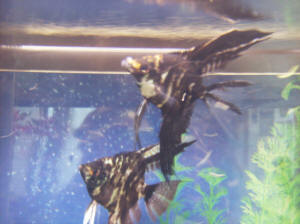
|
|
Orange spots on edge of angel fish fin
10/23/07 Good Day, I have asked my local aquarium store fish
specialist and used numerous web databases to try and find out
what the orange spots on edge of my angel fish fins are. They
just appeared yesterday (see attached photo). There doesn't
seem to be any fin deterioration or rot, and no white fungal
growths. There are two angel fish in the tank (20 gallon) and
only one is affected by the orange spots so far. I have a
20-gallon octagon tank with a Pelican bio wheel filtration
system. A brief history of recent events in the 20-gallon tank:
1. Three weeks ago: I noticed that the male angel was getting a
bit of white growth on the bottom of his mouth but none on the
female angel. He has had this occur periodically over the last
three years - so I treated the tank with Furan-2 as this usually
takes care of the problem. I followed the directions of the
Furan-2 package for dosing and water changes. After the treatment
was finished, I did the final 25% water change and put in a new
carbon filter. 2. The male seemed recovered but the female was
beginning to shoe signs of distress. Her abdomen was swollen,
"panting" when breathing; she wasn't eating - just
hanging out in the back of the tank. I talked to my local
aquarium store fish specialist and he suggested that I switch to
Maracyn-Two. So, I treated the tank for the recommended five
days. The female began eating some and seemed to be recovering.
3. Then the tank took a bad turn. Seems the Maracyn-Two killed
all of my good bacteria. Water quality: ph was about 7, ammonia
was zero, but the nitrate was high. The tank clouded up, so I
began dosing the tank daily with Cycle to rebuild the nitrifying
bacteria population. The tank cleared in about four days. 4. The
female was still swimming around and more active but still not
feeding very well. The local aquarium store fish specialist
suggested that the female might be egg bound. So, I looked this
up on a web database and the suggestion was 1 tablespoon of Epson
salt per 10 gallons of water. I treated the tank once and the
female seemed to perk up a bit more. But was still not very
interested in eating. These angels usually eat right away and I
feed them twice a day. So, here we are now with the orange spots
on the edge of the females fins. She is not eating when I observe
at feeding time, but both of these angels have the habit of
grazing on bits of food that they miss that settles on the bottom
of the tank; maybe she is eating that way. The water quality
today is: was about 7.2, ammonia was zero, but the nitrate was
still high. My local aquarium store fish specialist today
suggested the Nitra-Zorb filter media to rebalance the water
quality. I bought one this afternoon and have removed my charcoal
filter and installed the Nitra-Zorb. Any ideas on what is causing
these orange spots? Joyce <Hi Joyce. At first glance, my guess
here would be that these are Finrot, and should be treated as
such. They might be some other bacterial infection (such as Mouth
Fungus) but most of these external bacterial infections will be
treated by anti-Finrot medication anyway. Don't waste time
with salt, Melafix, etc. Go straight for the antibacterial
medications. Do be sure to remove carbon from the filter if used.
Carbon not only removes medications before they do any good, but
they're also a waste of time and money. Far better to replace
with real biological media that will do something useful. Hope
this helps, Neale>
|
|
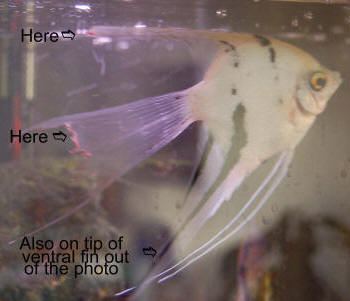
|
|
Angelfish behavior 6/18/07 Hello
Crew, <Hello.> Thank you so much for your speedy reply. I
am disappointed to say that I have new developments with the
angels. <Oh dear.> The bubble swimming continues with no
change and they are swimming up stream toward the power head) but
one of my angels has a few other symptoms now and I would like
your personal opinion on which medication to try next, I hate to
put them through more than one due to the unnecessary stress it
causes. <OK.> So last time (5 weeks ago) I used Maracyn-Two
and that was when only one fish was showing symptoms and they
weren't that clear. <Wouldn't have been my response.
Antibiotics are potent tools and used improperly cause more harm
than good. If used at all, they're used last of all. It's
also axiomatic of good medicine that you don't use a
treatment until you've identified the problem.> Now
another angel has some "stuff" (pictures attached)
around base of his left pectoral fin. <At first glance I'd
have said it looks like fin rot. The odd thing is that the fin
membrane itself looks fine, it's the base of the fin that is
infected. Typically, fin rot works from the distal end of the fin
(the "fringe") inwards to the base.> This has been
there for the duration of the problems but was much smaller and
was hard to tell if it was just an imperfection. Now it is very
obvious it is nothing of the kind and needs attention; could this
also be what is making the bunch swim crooked from time to time?
<Hard to see how or why, except this: when fish find
themselves in the wrong water conditions, their instinct is to
swim out of them. In the aquarium, this manifests itself by
swimming into the current. Now, couple this was Finrot (or
possibly Columnaris (a Flexibacter infection) and you have two
signs indicating that not all is well in the aquarium. Not proof,
but an indication. At the very least, check ammonia or nitrite,
nitrate, and pH as these will give you a good handle on the
environment. Fin rot is definitely associated with high levels of
nitrite and ammonia, and Columnaris tends to be common in
overstocked tanks or tanks where water changes are infrequent
enough, and the nitrates will indicate this nicely. You're
aiming for ZERO nitrite and ammonia, and under 50 mg/l nitrate
(ideally under 20 mg/l). The pH for tank-bred angels should be
around 6.5-7.5.> In my past experience with infections they
have progressed so much faster than this so I am in new
territory. <Depends on the infection. Viral infections like
Lymphocystis take quite literally years to develop and then fade
away, while other infections go from nothing to life threatening
in days, as with whitespot.> All the descriptions for
treatments I have looked at describe the cotton-like stuff and I
have seen that many times and this looks different. <The three
"fin" infections are Finrot, fungus, and Columnaris
(sometimes, but inaccurately, called "mouth fungus",
even though it can occur on more than the mouth and isn't
caused by a fungus). Fin rot is usually a pink infection where
the fin membrane dissolves but the bones are left behind,
creating a ragged appearance. Fungus looks like off-white threads
and almost always is associated with mechanical damage such as
fin-nipping or poor handling. Mouth fungus is usually a greyish
slime with a texture like short tufts or threads. Commonly on the
mouth (hence the name) but can occur elsewhere. Almost always
occurs on fish kept in fetid, poorly maintained aquaria.> It
is light peach colored and more dense and localized. <I agree,
it is odd. But I'd assume it is fin rot and treat
accordingly.> Hopefully you can see this from the pictures.
Also I attached another picture showing the "hair like"
extensions you were wondering about. Hope I was right in thinking
they were a good sign. <Just the style of fancy angelfish you
own. Wild angels don't have these threads, but some of the
artificial varieties do.> Thanks again and I will be awaiting
your reply. <Cheers, Neale>
|
|

.JPG)
|
| FW Angel injury, 2ndary inf.
4/28/07 Hello Crew, <Chris> This is truly a great
website, and I wouldn't have the five healthy tanks I now have
without it. <Glad to help> I'm hoping you can help
diagnose and treat a problem that one of my angelfish
has. This is the male of a breeding
pair. After the latest spawn hatched I saw the male and
female fighting with the female aggressively attacking his eyes
(three days ago). I removed the female and quarantined
the male. The next day, he was laying on his side on the
bottom. Using the net, we were able to get him back
upright, and he now swims on his own; however, he's still not
eating. I'm doing 20% water changes twice daily in
the 15 gallon tall tank he's currently housed in, but I
haven't medicated with anything. I'm hoping the
photos I've included are clear enough to see the fuzz
that's on his eyes. He also has a wound beneath his
right gill plate that I won't show up on the camera. <I see
this...> I've also included a photo I took when he was
healthy. <Thank you> Thanks Chris <Does appear to be a
secondary infection consequent to the fighting... I would elevate
the water temperature to the low eighties F. and administer a Furan
compound... likely Nitrofurazone... at 250 mg. per ten gallons,
changed out three times, every three days... and continue
trying/offering foods. Bob Fenner> |
|
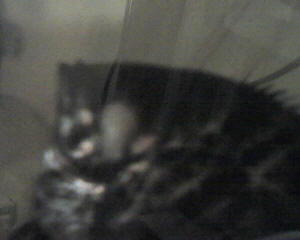
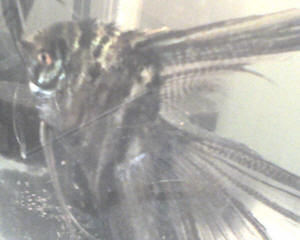
|
| Re: FW Angel injury, 2ndary inf.
5/9/07 Hi again Bob, <Chris> Thanks for the
help. The infection has cleared up and 100%
gone. However, the fish has been left
blind. The right eye fell out, and the left is
white. I don't know enough about angel physiology to
know exactly how to care for him, and he still hasn't
eaten. He swims well and stays upright, and I know
angels are prone to going on hunger strikes. <This
fish can survive, live a good life sans the eye> So, the
question is: Is this a hunger strike, or is he unable
to find the food because he's now blind? If the
latter, is there a way for me to help him adjust, or will I need to
euthanize? <Keep offering small bits of food (discrete, like a
good pellet type... my fave currently, Spectrum brand)... in about
the same place, time... along with perhaps some live Tubificid
worms... in a suspended worm cup...> Additionally, I forgot to
give the history of this particular pair in my haste to find
treatment for the infection. The male from my original email is the
second mate for the female that attacked him. As I said
earlier, I removed her. She's currently in the
community tank. <Good> Her first mate was a gold veil that
after the fourth spawn showed symptoms similar to the second male
with the exception of the infection being limited to one
eye. My thoughts at that time were that I had in some
way failed to properly care for the pair. When the
symptoms revealed themselves the first time, I removed the male
from the breeding tank to a qt tank where he lived for about a
month before becoming so weak that I euthanized. Meanwhile I had
returned the female to the community tank. She
subsequently mated with the male that was the subject of my
original question. She has now mated with another male,
although I've yet to transfer the pair to a breeding tank.
<I see> Additionally, since this female has always been an
attentive parent, I've always left the eggs and fry in the
breeding tank for the first two weeks. My thought is/was that she
understands the needs of the fry better than I. My questions: Is it
normal behavior for one angel fish in a mated pair to aggressively
attack the other after spawning? <Mmm, not totally uncommon, but
trouble> I've not had this issue with any of my other pairs.
Since this female selects her mates well, I'd like to continue
breeding her; but not if she'll continue killing the
males. Will removing the eggs and hatching them from a
different tank resolve her aggression issues which only manifest
after spawning? <Good idea. Especially if you're involved in
this commercially, I would remove all said spawning media/eggs and
raise independently...> I've included pictures of the female
and her third mate. The female is the one with the gold
markings (second photo) around the eye and top. Since
there's no point of reference for scale, she's about four
inches. All three males have been six or more inches
with two or three times her body mass. Thanks again, Chris
<Thank you for your careful reporting, sharing. Bob
Fenner> |
|
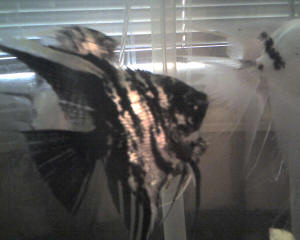
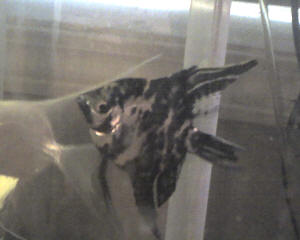
|
| Wild FW Angelfish With Bacterial
Problem 2/18/07 Hi. My wild-caught angelfish
are getting spots (sores). One has met his maker already
and another is close on his heels. Please help!! My
tank: 55g, freshwater, no live plants, 5 angelfish (6 originally)
4-5 inches tall, 15 lemon tetras, 5 o-cats, & 3 Cory
cats. I change 25% every week (occasionally I go 2 weeks
but I've check the nitrates and it's always under
20). The history: Several weeks ago an angel got a sore
(white-ish) and I figured it to be a wound from the rocks (sometime
my kids spook them and they'll freak out bouncing of whatever
is near). I salted lightly and waited. A
couple of weeks go by and it only get's bigger. Then
I thought it was a secondary infection on the wound so I treated
with Pimafix and Nitrofurazone (sp?). During the
treatment week the first angel died. I finished the dose
and everything seemed normal...The problem: Now there is one more
angel with sores, a cluster of black and white sores just under his
dorsal fin on one side (see pics). Also the lemons have
developed a few problems. The worst is one whose anal
fin is gone and there is a "v" notch missing from his
underside (see pic). Another lemon has red streaks on
his side and yet another has a small red sore around his mouth. I
don't care so much about the lemons, but I'd rather not
loose any more angels. Please help me diagnose and
decide on a treatment. Thanks a bunch. Jeff < Wild
fish are always more difficult to keep alive than domestically
raised fish. First of all you did not quarantine the fish. Wild
fish can carry an whole bunch of parasites that can spread to other
fish. Wild angelfish like warm soft acidic water. The lower pH of
the Amazon basin actually inhibits some diseases. If your pH is
above 7 then your angelfish are being subjected to a bunch of
diseases that they would never encounter in the wild. Nitrofurazone
worked the first time but the disease came back. This tells me that
it is bacterial and that what ever caused the problem in the first
place is still causing the problem. For now I would recommend a 50%
water change, vacuum the gravel and clean the filter. this should
take care of the immediate problems. To care for these angels long
term I would recommend that you soften the water and lower the pH
to under 7. At pH 6 bacteria have a much harder time surviving. The
easiest way to do this is with an R/O unit and a good buffer. I
think you angels will be much better off. Domestic angels are much
hardier to water quality and aquarium conditions than their wild
counter parts.-Chuck> |
| Re: Wild FW Angelfish With Diseases
II 2/18/07 So you don't recommend another round of
medication? < You need to medicate to get rid of the problem
now. Nitrofurazone may still work if the bacteria have not become
resistant. The disease may come back after the medication is gone
because conditions have not changes. I would try the Nitrofuranace
again to take care of the immediate problem while looking into
softening the water and lowering the pH. Lts of articles/questions
on this in the WWM archives.-Chuck> |
|
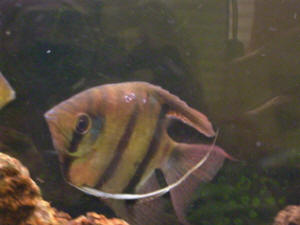
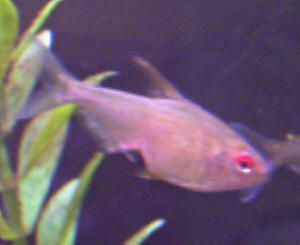
|
Tail-less Angelfish 5/11/06 Can you please direct me to
a medicine to cure fin rot for angels on your site, because my angel
has not been getting worse but he still does not have a tail and he has
had a tiny stub for about 4 months now. Any suggestions? Thanks < If
the infection has already made it up to the caudal peduncle then it
will not grow back. Next time try Nitrofuranace.-Chuck>
Urgent!!! Help PLEASE!!!!!
Angelfish fry deaths 9/26/05 We have been breeding Angel Fish for
approx. 6 yrs now. We have come across a problem we
can't seem to find a remedy for. All our fry are dying
within 3 days of hatching and never seem to come up to
swim. We have quite an elaborate system set up in our
basement. Each tank having its own filtering system (to
avoid cross contamination from other tanks) and a large holding tank
where the water is filtered, heated and tested before use in changing
water in the fish tanks themselves. Currently we have
1-150gl tank, 9-70gl tanks, 1-35gl tank, 3-30gl tanks and 4-10gl
tanks. Our 10gl tanks are the ones we use for fry hatching
away from the parents. We are on a well water
system. 3 months ago we had a lab come out and test the
water in the well. All came back within normal limits with
Iron (Hard water) being just a tad on the high side of the normal, but
still within the normal limits. Our batch that hatched 2
days ago were all found dead this morning. Out of no where
it almost looks like white dust floating all in the
tank. What ever it is, they appear to be floating/swimming
on their own. Not so much as ONE fry is left anywhere to be
found. Only these white specks. Is it possible,
that when the well water is brought up to temp in a tank, it wakes up
some kind of "bug" (for lack of a better word) that is
killing our fish?? Have you ever heard of anything like this
before or are aware of anything to correct this problem. We
are quickly running out of Angels here and it is becoming very
frustrating. We have checked and double checked all levels
in tanks, holding tank and well system and can't seem to come up
with any reason our fry keep dying off. >> I would have to guess,
but it is likely that you have a parasite on the loose in your tanks
that is not affecting the adults. Best guess would be Cryptosporidium
which is famous for killing fry. You can treat the water with general
antiparasitic medications and see if this resolves the problem, after
that you should check to see if there is maybe some heavy metals in
your source water that are affecting the fry. Good Luck,
Oliver
|
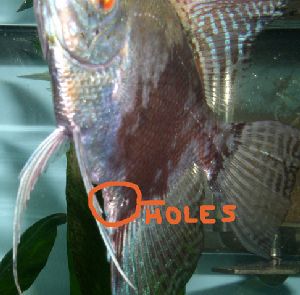
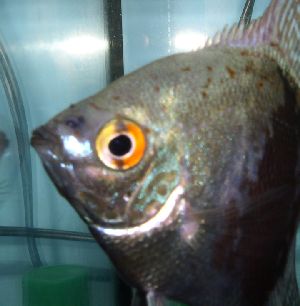
|
|
Angelfish, Bacterial Infection, Great Images
- 11/05/2005 Hi, I really need some help regarding my
freshwater angelfish. I have already posted my problem on a
number of different forums and it seems no one knows what I'm
dealing with. My angelfish has developed black wormy things
underneath his skin. <A picture is worth a thousand
words.... your images are excellent.> It first started out as
a white lip fungus but then I noticed black things burrowing
underneath in his head area. These worms (or bacteria) started
pushing through his skin and leaving black protruding bumps.
Then, the next day, almost as quickly as they came, they
disappeared back into the skin and left a small hole. I first
tried 50 percent water changes every day and since that
didn't seem to help, I put him on MelaFix and PimaFix.
<These are worthless in my opinion. Really of no quantifiable
value.> Again, this worked very little so I switched to Jungle
Fungus Eliminator. This cleared up the holes very well until I
noticed three more near his anal fin. I can also still see the
worms inside him. <I do not believe these are worms.
Your images appear to me to suggest a bacterial infection quite
clearly.> Someone else told me that probably the only solution
is to humanly destroy the fish, sterilize the tank, and then
start over. <I very much disagree.> I would really
like more options than this. <There are.> I have also
attached pictures. Thanks for any help you can offer. <I would
treat with a broad-spectrum antibiotic (Kanamycin sulfate is one
good option, or perhaps Oxytetracycline in food, if you can
find). At Anthony's suggestion, I treated an Altum angel with
extremely similar symptoms successfully with salt - bringing the
specific gravity to 1.003 for a couple of weeks. You could try
this instead. This animal is not a "lost cause"....
likely can be medicated with success.> <Wishing you well,
-Sabrina>
|
|
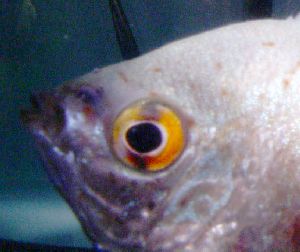
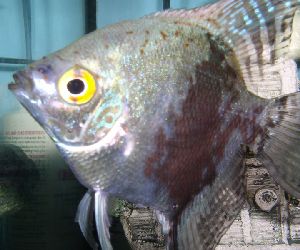
|
Angelfish With Internal Bacterial Infection
10/27/05 HELP!!!!!! PLEASE!!!!!!!!! <We will try.> I have
three angelfish who are swimming on their sides. They started out in a
55 gallon tank with 3 other angels,3 snails and a black moor. <
Goldfish and tropical fish together are not really s good idea.
Eventually one or the other will get sick from being either too warm
(goldfish) or too cold (angelfish).> One by one they seem to start
floating on their side. They are trying to eat and swim on their sides.
I did a water change and bumped their temp to 82. I am treating
them with PimaFix and MelaFix. Also their blushing angels and the red
spot seems to spread from their cheek outward. A larger circle. I
noticed my other angels seem to be redder too in that area. One
angelfish's lips look swollen. I have the three that are swimming
on their side in a sick tank. Please any advice. I called my LFS where
I bought them and they just said to flush them. I can't do that.
They are trying so hard to live. Any response is appreciated.-Brandy
and Melody < Do a 30% water change, vacuum the gravel and clean the
filter. Treat with a combination of Metronidazole and Nitrofurazone
with some rock salt added to the water. Do a 50% water change every
other day and remedicate on the days you don't change water. This
should take care of the organisms causing the problems but it may take
a while for your fish to completely heal if they survive the
treatment.-Chuck>
Angel fish with white eye growth My
Angel Fish's eye clouded over and the whiteness continued to grow
until it was about 4x the size of his eye and was loosely flapping as
he swam--it literally looked like he had a small wet cotton ball
attached to his eye. I finally got the net out and scraped
it off as he swam by. It took half his eye with
it. I've searched on the web but can't find anything
even remotely related to this. I'm assuming he's
blind in that eye now, so what I'd like to know is whether or not
it can spread to the other fish or is going to kill him. <
Unfortunately fish cannot close their eyes to protect them from injury.
Sometimes their eyes become damaged by rough handling in coarse nets
and that leaves them susceptible to infection. Next time gently wipe
the eye with a wet cotton ball to remove the majority of the fungus and
treat the tank with Maracyn or erythromycin. Do a 30% water change,
make sure the filter is clean. Follow the directions on the package. It
may spread but if the water is clean and warm and the rest of the fish
are in general good health then it should not spread.-Chuck> Thanks,
Amy Woods
Angels can't swim! Hey there my angel fish
have stopped swimming. Their tails have folded up and there long fins
have gone thin and superficial. They just lie on the bottom, not
eating. What is wrong and how can I fix it? < You have a bacterial
infection. Do a 30% water change and clean the filter. I would treat
with a medication called Furanace. If that is not available then try
Maracyn. These medications also affect the good bacteria that break
down fish waste. Watch for ammonia spikes. -Chuck>
FW Angelfish Lip Tumor? Writing
from Jamaica. I've got a 95 or so gallon home-made tank on my
balcony housing some little Oscars, a clown loach, Plecostomus and a
collection of native river gobies and Gambusia (sp?) that I'm
collection for a guy at UWI. I've inherited a lovely, though
heavily inbred, large angelfish from a neighbor's tank that it had
outgrown. It's lips, both top and bottom are covered in a fleshy,
pinky-gray tissue (tumor), which seems to make its feeding difficult
but otherwise seems all right, though ugly. It sounds like Phillo.
(I've forgotten) according to the internet literature, though it
did come from a tank that was too small. With the illness, I'd love
to have not accepted the fish, but the neighbors kids wouldn't have
taken it so well. They're new to ecology and survival of the
fittest. This tumour situation seems very common among angels sold in
Jamaica. I think there are only a few breeders, or less. Every shop
seems to sell very similar angels. Could you give a better description
of what this tumor Phillo. looks like, how it might compare to a
tank-side chronic bruise or, as suggested on this forum a bacterial
infection, is it infectious (if Phillo., no) and will it go away or can
I surgically excise it/them, and if I do will they grow back? I reckon
that these tumors will eventually hinder the animal's feeding
enough that it will fade and float. < I have seen this before in
heavily inbred angelfish and it was assumed to be caused by a virus
since no parasites could be found. If this is the case then it cannot
be cured. I recommend destroying the fish and trying to get some new
bloodlines.-Chuck>
|
|

